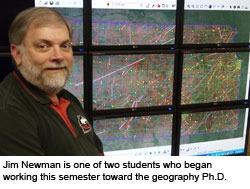The mantra of real estate agents also could be the motto of the NIU Department of Geography, which kicked off a new academic program this semester leading to a doctorate degree.
NIU is now the only university in northern Illinois and one of only two statewide offering a Ph.D. in geography. It’s a logical extension, given NIU’s setting.
“If you want to study geography, we’re located in one of the most favorable places in the United States,” says Andrew Krmenec, geography chair. “We’re in close proximity to Chicago and are part of one of the largest regional economies in the country. We’re also near the juncture of the Great Plains, Great Lakes and Mississippi Valley climatic regions. We sit on the edge of the former tall-grass prairie, at the northern tip of Tornado Alley and amid some of the most productive farmland anywhere.
“We’re a geographic observatory to the world,” he says.
The Illinois Board of Higher Education approved the Ph.D. offering last summer. But Krmenec says the geography department first began to ponder the program decades ago and started to pursue it in earnest in the late 1990s.
“We began seriously thinking about it after we had invested in rebuilding the undergraduate program and strengthening the master’s program,” he says. “You must have an incredibly sound undergraduate and master’s program if you’re going to be successful with the Ph.D.”
In terms of majors and undergraduate degrees granted per year, NIU boasts the largest geography program in Illinois and one of the largest undergraduate-only meteorology programs in North America. About 200 NIU students are pursuing undergraduate degrees in geography; another 35 are working toward master’s degrees.
The Ph.D. program intentionally is much smaller – the aim is to build it up to an optimum enrollment of 12 to 15 full- and part-time students. Some program graduates will go on to university professorships while others will help meet an increasing demand for highly sophisticated expertise in geographic analysis. The field has grown rapidly in recent decades with geospatial technologies driving applications and research.
In Illinois, the northern third of the state is home to a large employment base for businesses, consultants, private industry and non-profit organizations that increasingly rely on geospatial analyses on such topics as traffic movement, soil quality, flood zones, land suitability, economic development, regional planning, precision agriculture, environmental hazards and population distributions.
“I’ve been fascinated with maps and mapping ever since I was a kid,” says Jim Newman, one of two students who began working toward the geography Ph.D. this semester.
A former information technology specialist who holds an M.B.A. in finance from the University of Chicago, Newman owns a small business that specializes in spatial data analysis, mapping and regional planning using geographic information systems (GIS). After earning a graduate certificate in Geographic Information Analysis from NIU in 2009, the resident of Campton Hills in western Kane County decided to continue his studies and work toward the Ph.D.
“With the convenience of being near NIU and having had some experience with the geography department, it made for an easy decision to stay here and work on the degree,” says Newman, who has done some teaching at the college level. The doctorate will strengthen both his teaching and business credentials.
“The Ph.D. ties several of my interests together, particularly working with maps and the analytical aspects of dealing with GIS,” he says.
Students in the Ph.D. program can choose an emphasis in spatial environmental science or human spatial science. Both areas attempt to identify and understand geographic relationships, such as the effects of sprawl on traffic patterns or the impact of climate change on human activities.
Ph.D. candidates must hold a master’s degree, but it doesn’t have to be in geography, according to the department chair.
“We have applicants with degrees in architecture, business, civil engineering, urban planning and the atmospheric sciences,” Krmenec says. “Yet their interest is primarily focused on geography, or how humans use space and how things are distributed by nature across geographic space.
“A love of maps also helps,” he adds. “For a lot of people, that’s how they describe their interest in geography. We believe everything can be mapped.”

